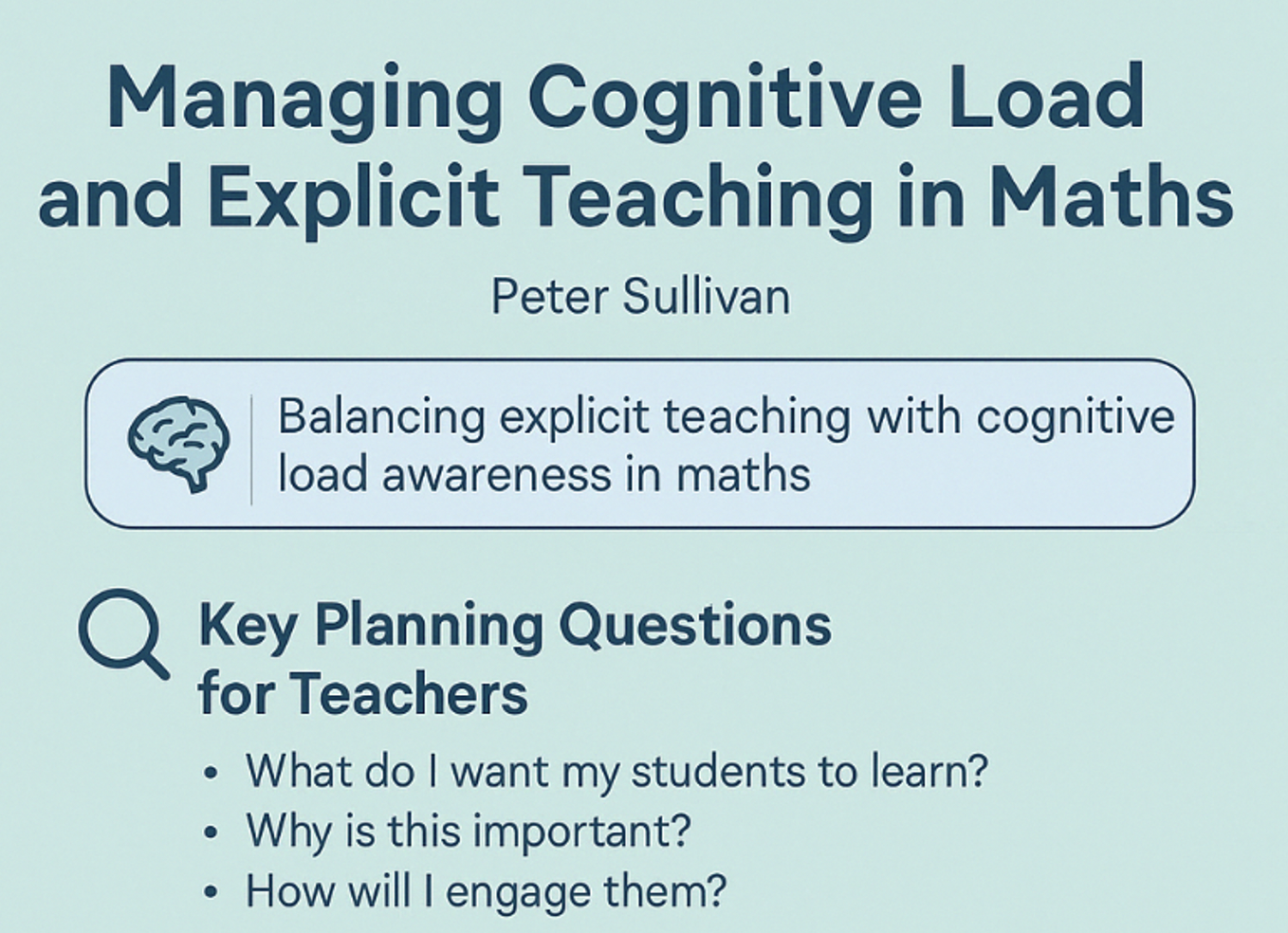Managing Expectations Around Cognitive Load and Explicit Teaching in Maths
Peter Sullivan – May 2025
Many teachers are struggling with implementing policy requiring the teaching of mathematics by being 'explicit’ when planning and teaching, while also being mindful of straining the cognitive load on students. The best way forward is for teachers to focus on the nature of effective mathematics teaching.
There are three key questions teachers ask themselves when planning and teaching:
what do I want my students to learn?
why do I want them to learn this?
what experiences can I offer to engage them in this learning?
What
The what is determined by the curriculum, written to include understanding, fluency, problem solving and reasoning. The aspect most closely connected with the curriculum is understanding which is best thought of as a mix of “how” and “why”. It is possible to focus just on the “how”. But this is a risk. Students are more likely to remember and use mathematical ideas if they know “why” a procedure works. For example, it is possible to teach students to add fractions like + by a rule which says “multiply the denominators, cross multiply to get the numerators then add them”. This is an example of a rule without reason. But the process will be more readily remembered and used correctly if the teacher explains to students the process of finding a common denominator to make the fractions equivalent, so it would look like + . This latter method, based on “why”, is more flexible, more likely to be used correctly, and leads students to see the connections between the concepts. Mathematics is not about tricks and rules but can be understood (“why” and “how”).
Why
The why is also connected to the “what” because in the discipline of mathematics we want students to learn and appreciate connections between ideas, use mathematics intuitively and apply mathematics in practical situations. By way of example, there was an argument on the radio about how to describe a cutback in government funded swimming lessons from 50,000 to 3,000; specifically finding the percentage reduction. The commentators found three different ways of finding the correct answer (94%) none of which was a formally taught method based on a rule. In fact, it is relevant to ask which of the three solution methods was correct. The answer, of course, is they can all be correct. In fact, students can learn effective processes from the teacher and also from intuitive methods developed by themselves and other students, if they understand the mathematics.
Improvements in NAPLAN scores are used as a measure of success. But almost all NAPLAN questions are solved by connecting two or more steps, by thinking intuitively and appreciating the context in which questions are posed. Students are more likely to answer such questions if they engage in classroom learning that fosters divergent ways of thinking and are less likely to answer multi-step questions if they have been told tricks and rules in simple steps, without reason.
Maths Experiences
Teaching is enhanced when choosing learning experiences that assume students are thinking, active, engaged learners who have opportunities to solve problems and reason mathematically. Learners build connections within a single concept (for example, fractions), between related concepts (say, fractions and decimals), across various learning areas (using fractions in science), and with applications (such as probability). Some say such teaching increases cognitive load in ways that make learning difficult. Rather than avoiding challenges however, (the mathematics we want student to learn is complex, after all) it would be better for teachers to help students manage the risk of exacerbating cognitive load, prior to engaging with the challenges by:
Clarifying any language involved
Checking for student interpretation of representations and/or contexts
Addressing potential barriers and misconceptions explicitly
Revising and practising relevant pre-requisite fluency
Clarifying expectations for the learning experience
Presenting and clarifying Learning Intentions (what, why, how).
Another consideration related to planning learning experiences is to accept that mathematics teaching is more effective when teachers recognise there are different levels of readiness-to-engage in every class. Pitching content to the lowest common denominator does not do this. Learning experiences that suitably engage most students, offer prompts for students experiencing difficulty, and for those ready for further challenges, are more likely to accommodate the needs of all students.
In summary, teachers can be explicit for students and themselves by considering the “what” and “why” of mathematics and learning experiences that support students engaging with the curriculum, while anticipating and managing challenges to students’ cognitive load, and preparing ways of dealing with differences.


